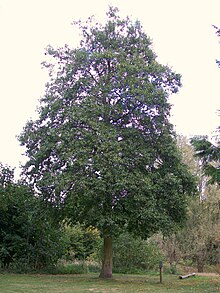
Alders are trees that compose the genus Alnus in the birch family Betulaceae. The genus includes about 35 species of monoecious trees and shrubs, a few reaching a large size, distributed throughout the north temperate zone with a few species extending into Central America, as well as the northern and southern Andes.

Quercus cerris, the Turkey oak or Austrian oak, is an oak native to south-eastern Europe and Asia Minor. It is the type species of Quercus sect. Cerris, a section of the genus characterised by shoot buds surrounded by soft bristles, bristle-tipped leaf lobes, and acorns that usually mature in 18 months.
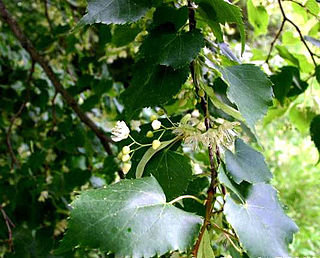
Tilia cordata, the small-leaved lime or small-leaved linden, is a species of tree in the family Malvaceae, native to much of Europe. Other common names include little-leaf or littleleaf linden, or traditionally in South East England, pry or pry tree. Its range extends from Britain through mainland Europe to the Caucasus and western Asia. In the south of its range it is restricted to high elevations.

Alnus glutinosa, the common alder, black alder, European alder, European black alder, or just alder, is a species of tree in the family Betulaceae, native to most of Europe, southwest Asia and northern Africa. It thrives in wet locations where its association with the bacterium Frankia alni enables it to grow in poor quality soils. It is a medium-sized, short-lived tree growing to a height of up to 30 metres (98 feet). It has short-stalked rounded leaves and separate male and female flowers in the form of catkins. The small, rounded fruits are cone-like and the seeds are dispersed by wind and water.

Alnus rubra, the red alder, is a deciduous broadleaf tree native to western North America.
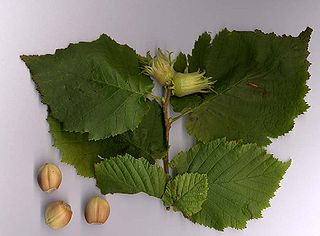
Corylus avellana, the common hazel, is a species of flowering plant in the birch family Betulaceae, native to Europe and Western Asia. It is an important component of the hedgerows that were, historically, used as property and field boundaries in lowland England. The wood was traditionally grown as coppice, with the poles cut being used for wattle-and-daub building, and agricultural fencing.

Pinus halepensis, commonly known as the Aleppo pine, also known as the Jerusalem pine, is a pine native to the Mediterranean region.

Alnus incana, the grey alder, tag alder or speckled alder, is a species of multi-stemmed, shrubby tree in the birch family, with a wide range across the cooler parts of the Northern Hemisphere. Tolerant of wetter soils, it can slowly spread with runners and is a common sight in swamps and wetlands. It is easily distinguished by its small cones, speckled bark and broad leaves.

Quercus trojana, the Macedonian oak is an oak in the turkey oak section (Quercus sect. Cerris).

Alnus subcordata, the Caucasian alder, is a species in the family Betulaceae, prevalent in the Hyrcanian woodlands situated in the Caspian Mountains of northern Iran and southeast Azerbaijan. It is closely related to the Italian alder and Alnus orientalis.
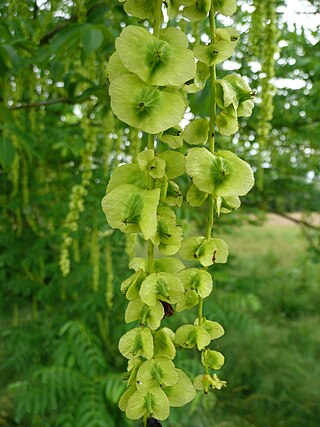
Pterocarya fraxinifolia is a species of tree in the Juglandaceae family. It is commonly known as the Caucasian wingnut or Caucasian walnut. It is native to the Caucasian region Armenia, Azerbaijan, Georgia, Iran, Russia, Ukraine and Turkey. It was introduced to France in 1784, and to Great Britain after 1800.

Frangula alnus, commonly known as alder buckthorn, glossy buckthorn, or breaking buckthorn, is a tall deciduous shrub in the family Rhamnaceae. Unlike other "buckthorns", alder buckthorn does not have thorns. It is native to Europe, northernmost Africa, and western Asia, from Ireland and Great Britain north to the 68th parallel in Scandinavia, east to central Siberia and Xinjiang in western China, and south to northern Morocco, Turkey, and the Alborz in Iran and the Caucasus Mountains; in the northwest of its range, it is rare and scattered. It is also introduced and naturalised in eastern North America.

Phytophthora alni is an oomycete plant pathogen that causes lethal root and collar rot in alders. It is widespread across Europe and has recently been found in North America. This species is believed to have originated relatively recently.

Taphrina alni is a fungal plant pathogen that causes alder tongue gall, a chemically induced distortion of female alder catkins.

Agelastica alni, the alder leaf beetle, is a species of leaf beetle (Chrysomelidae) in the genus Agelastica. Agelastica alni is distributed in Europe, the Caucasus, Siberia, north-eastern Kazakhstan, and in the 19th century was introduced to the United States.

Ostrya carpinifolia, the European hop-hornbeam, is a tree in the family Betulaceae. It is the only species of the genus Ostrya that is native to Europe.

Frankia alni is a Gram-positive species of actinomycete filamentous bacterium that lives in symbiosis with actinorhizal plants in the genus Alnus. It is a nitrogen-fixing bacterium and forms nodules on the roots of alder trees.

Alnus serrulata, the hazel alder or smooth alder, is a thicket-forming shrub in the family Betulaceae. It is native to eastern North America and can be found from western Nova Scotia and southern New Brunswick south to Florida and Texas.

Alnus alnobetula is a common tree widespread across much of Europe, Asia, and North America. Many sources refer to it as Alnus viridis, the green alder, but botanically this is considered an illegitimate name synonymous with Alnus alnobetula subsp. fruticosa.
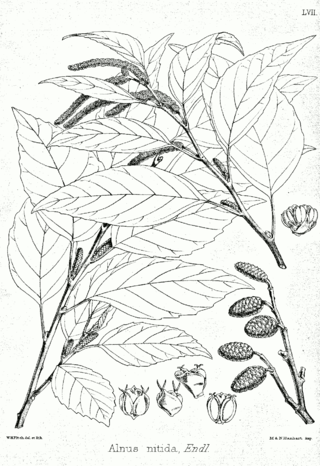
Alnus nitida, the west Himalayan alder, is a species in the genus Alnus, native to Pakistan, the western Himalayas, and Nepal. It is a tree reaching 20 to 25 m, preferring to live along the banks of rivers. It is used locally for timber and firewood, and as a street tree. The bark is used in some places for tanning and dyeing purposes. It grows well in heavy, clay soils and tolerates infertile soils. The leaves are thin, oval to ovate, 3-6 inches long and 2-3 inches wide. Female flowers appear first, followed by male catkinss in September to October, which may be up to 19 cm long. The fruits are woody cones, typically 2.5-3.5 cm long.
